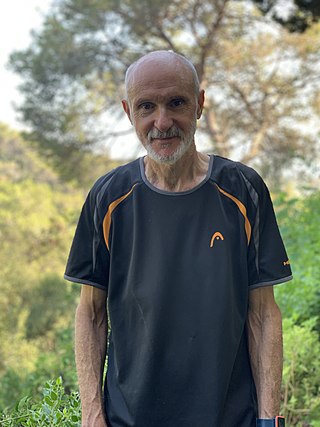
In academic publishing, a preprint is a version of a scholarly or scientific paper that precedes formal peer review and publication in a peer-reviewed scholarly or scientific journal. The preprint may be available, often as a non-typeset version available free, before or after a paper is published in a journal.

Sir William Timothy Gowers, is a British mathematician. He is Professeur titulaire of the Combinatorics chair at the Collège de France, and director of research at the University of Cambridge and Fellow of Trinity College, Cambridge. In 1998, he received the Fields Medal for research connecting the fields of functional analysis and combinatorics.

Ben Joseph Green FRS is a British mathematician, specialising in combinatorics and number theory. He is the Waynflete Professor of Pure Mathematics at the University of Oxford.
Citation impact or citation rate is a measure of how many times an academic journal article or book or author is cited by other articles, books or authors. Citation counts are interpreted as measures of the impact or influence of academic work and have given rise to the field of bibliometrics or scientometrics, specializing in the study of patterns of academic impact through citation analysis. The importance of journals can be measured by the average citation rate, the ratio of number of citations to number articles published within a given time period and in a given index, such as the journal impact factor or the citescore. It is used by academic institutions in decisions about academic tenure, promotion and hiring, and hence also used by authors in deciding which journal to publish in. Citation-like measures are also used in other fields that do ranking, such as Google's PageRank algorithm, software metrics, college and university rankings, and business performance indicators.
Quantum is an online-only, open-access, peer-reviewed scientific journal for quantum science and related fields. The journal was established in 2017. Quantum is an arXiv overlay journal, meaning the journal's content is hosted on the arXiv.
In applied mathematics, topological data analysis (TDA) is an approach to the analysis of datasets using techniques from topology. Extraction of information from datasets that are high-dimensional, incomplete and noisy is generally challenging. TDA provides a general framework to analyze such data in a manner that is insensitive to the particular metric chosen and provides dimensionality reduction and robustness to noise. Beyond this, it inherits functoriality, a fundamental concept of modern mathematics, from its topological nature, which allows it to adapt to new mathematical tools.
An overlay journal or overlay ejournal is a type of open access academic journal, almost always an online electronic journal (ejournal), that does not produce its own content, but selects from texts that are already freely available online. While many overlay journals derive their content from preprint servers, others, such as the Lund Medical Faculty Monthly, contain mainly papers published by commercial publishers, but with links to self-archived preprint or postprints when possible.
In probability theory, to postselect is to condition a probability space upon the occurrence of a given event. In symbols, once we postselect for an event , the probability of some other event changes from to the conditional probability .
In the study of permutation patterns, there has been considerable interest in enumerating specific permutation classes, especially those with relatively few basis elements. This area of study has turned up unexpected instances of Wilf equivalence, where two seemingly-unrelated permutation classes have the same numbers of permutations of each length.

The Cost of Knowledge is a protest by academics against the business practices of academic journal publisher Elsevier. Among the reasons for the protests were a call for lower prices for journals and to promote increased open access to information. The main work of the project was to ask researchers to sign a statement committing not to support Elsevier journals by publishing, performing peer review, or providing editorial services for these journals.
The Polymath Project is a collaboration among mathematicians to solve important and difficult mathematical problems by coordinating many mathematicians to communicate with each other on finding the best route to the solution. The project began in January 2009 on Timothy Gowers's blog when he posted a problem and asked his readers to post partial ideas and partial progress toward a solution. This experiment resulted in a new answer to a difficult problem, and since then the Polymath Project has grown to describe a particular crowdsourcing process of using an online collaboration to solve any math problem.

Tamar Debora Ziegler is an Israeli mathematician known for her work in ergodic theory, combinatorics and number theory. She holds the Henry and Manya Noskwith Chair of Mathematics at the Einstein Institute of Mathematics at the Hebrew University.

Combinatorics, Probability and Computing is a peer-reviewed scientific journal in mathematics published by Cambridge University Press. Its editor-in-chief is Béla Bollobás.

bioRxiv is an open access preprint repository for the biological sciences co-founded by John Inglis and Richard Sever in November 2013. It is hosted by the Cold Spring Harbor Laboratory (CSHL).

In affine geometry, a cap set is a subset of where no three elements sum to the zero vector. The cap set problem is the problem of finding the size of the largest possible cap set, as a function of . The first few cap set sizes are 1, 2, 4, 9, 20, 45, 112, ....

Scholastica is a web-based software platform for managing academic journals with integrated peer review and open access publishing tools.

In geometry, a Danzer set is a set of points that touches every convex body of unit volume. Ludwig Danzer asked whether it is possible for such a set to have bounded density. Several variations of this problem remain unsolved.

Shmuel Onn is a mathematician, Professor of Operations Research and Dresner Chair at the Technion - Israel Institute of Technology. He is known for his contributions to integer programming and nonlinear combinatorial optimization.
Ryan O'Donnell is a Canadian theoretical computer scientist and a professor at Carnegie Mellon University. He is known for his work on the analysis of Boolean functions and for authoring the textbook on this subject. He is also known for his work on computational learning theory, hardness of approximation, property testing, quantum computation and quantum information.











